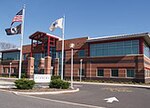Kin-Buc Landfill
Edison, New JerseyLandfills in the United StatesSuperfund sites in New Jersey

The Kin-Buc Landfill is a 220-acre (0.89 km2) Superfund site located in Edison, New Jersey where 70 million US gallons (260,000 m3) of liquid toxic waste and 1 million tons of solid waste were dumped. It was active from the late 1940s to 1976. It was ordered closed in 1977. Cleanup operations have been underway to address environmental issues with contamination from 1980s through to 2000s. This site was one of the largest superfund sites in New Jersey having taken in around 90 million US gallons (340,000 m3). The site is heavily contaminated with PCBs, which leaked into Edmonds Creek, a tributary of the Raritan River.
Excerpt from the Wikipedia article Kin-Buc Landfill (License: CC BY-SA 3.0, Authors, Images).Kin-Buc Landfill
Meadow Road,
Geographical coordinates (GPS) Address Nearby Places Show on map
Geographical coordinates (GPS)
| Latitude | Longitude |
|---|---|
| N 40.48571 ° | E -74.38015 ° |
Address
Meadow Road
Meadow Road
08817
New Jersey, United States
Open on Google Maps



